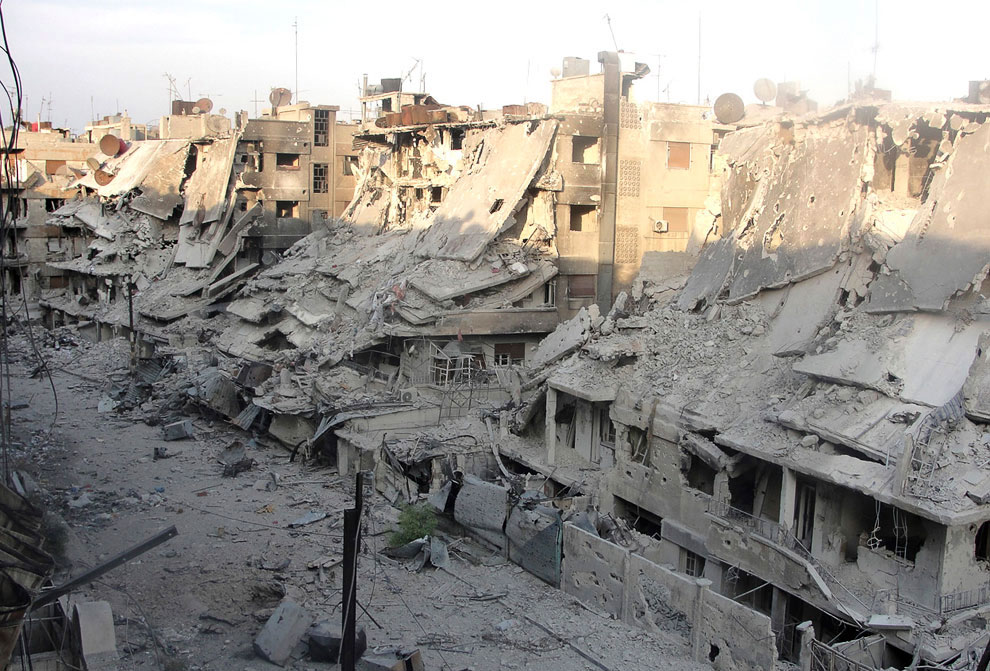Reconstruction Programs in Syria: The Next Conflict

The war machine rages on in Syria after more than two years, claiming the lives of civilians and destroying many of the towns and districts in the country. Notably, the City of Homs has seen two-thirds of its neighborhoods destroyed.
The death toll, now reported at about 100 thousand persons, has averaged 5,000 per month. The war has displaced more than 4 million people within the country, as well as 1.8 million refugees in neighboring countries.
The UN Economic and Social Council for Western Asia (ESCWA) has reported that one-third of real estate in Syria has been destroyed by shelling: 400,000 homes have been completely destroyed, and 300,000 partially destroyed. Meanwhile, infrastructure damage has affected 500,000 others.
The ESCWA report added that the largest share of the destruction has concentrated in the informal areas, where the most-impoverished people of Homs, Damascus, Aleppo, Dar`a, Dayr al-Zur and other cities live. An independent local study has reported on the application of an early mechanism for quantifying losses.* Another local report estimated that the number of homes totally destroyed amounted to 535,000, with an average 1,200 homes destroyed daily. In the first four months of 2013, some 475,000 homes were destroyed in part, mostly in informal and impoverished areas. The newly homeless from those areas have increased to more than 700,000 families, with no house to come back to.
Syrian Deputy Prime Minister Abdullah al-Dardari, previously in charge of economic affairs, has estimated reconstruction costs to exceed US$100 billion.
Two scenarios are emerging for the Syria reconstruction plan. One scenario is prepared by international bodies, whether the ESCWA or the European Union. The other has Abdullah al-Dardiri supervising plans prepared by the Asad regime, in cooperation with Russian and Iranian companies, and with Chinese support.
Western governments pose reconstruction programs along neoliberal models, as has happened in Palestine, Lebanon and Iraq. These have lacked sufficient private contractor accountability and standards of fair competition in contracting, while undermining the role of the state and bypassing community involvement in reconstruction projects. Iraq reconstruction has proffered a model of creating optimum private-sector opportunity through optimum destruction.
For more on reconstruction in war-torn cities, see Prospects for the Arab City Facing the Multiple Challenge of War, Conflict, Social Cohesion and the Fulfillment of Human Rights (Cairo: Housing and Land Rights Network, 2009) [on Iraq, pp. 22–26].
France, Spain and Italy have proposed to extend the reconstruction experience in Lebanon for Syria’s reconstruction program in Syria. They are poised to promote their own development of construction companies in those plans, not least as a way out of their European recession.
On the other hand, the Syrian government has prepared a reconstruction plan premised on regaining control of the cities and neighborhoods, dismantling communities in cities that opposed the Asad regime. The Syrian regime has had a history of dispossessing and demolishing the homes of political opponents, as practiced collectively against the Kurds since the early 1960s.
The current Asad plan seeks to remove all informal areas that represent a threat to his regime. Last year, Syrian government Resolution No. 18905 confiscated properties in some areas in order to carry out electric power projects. One of the inhabitants of those areas explained, Now, after [Asad] bombed us for several weeks, comes the day to complete the demolition of what has survived of the missiles, our security and livelihood. Meanwhile, the president of the Damascus Governorate clarified in March last year that he has been developing a scheme to re-plan slums, where there will be no housing ownership.
While the destruction continues systematically and out of control, especially after the military intervention of other parties in the conflict such as Hezbollah, some international agencies are promoting reconstruction plans in a post-Asad Syria. With an eye to the prospects for future reconstruction programs in Syria, the U.S. Special Inspector General Stuart Bowen has reported that $6–8 billion have been wasted in Iraq-reconstruction contracts.
Both scenarios raise concerns over the policy consequences of such reconstruction programs, especially since 50% of Syria’s residential areas are informal. Those residents do not have legally secure tenure to their original homes and plots, even if a structure remains to go back to. Millions of homeless and displaced will not be able to return to their neighborhoods.
In the end, it seems that the reconstruction plans form a battle that the Syrians have yet to await. Either scenario risks producing more victims among vulnerable and marginalized groups after a long period of displacement and loss of homes and property. Re-planning will not only determine the spatial dimension, but also construct a social fabric, newly rent by sectarian division.
* HLRN tools for calculating the consequences of violations of displacement and forced evictions:
HLRN Toolkit
Violation Database
Eviction Impact Assessment (EvIA) Tool
|